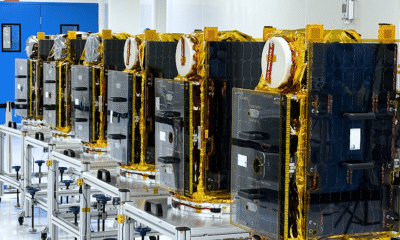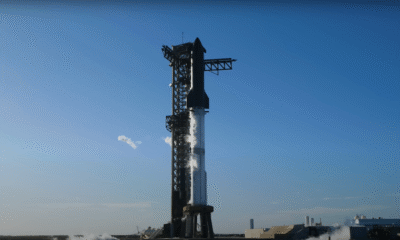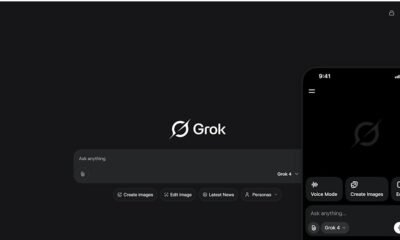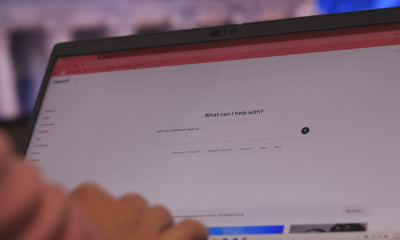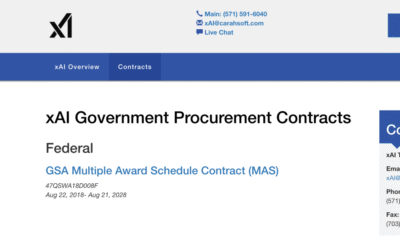Jobs & Careers
SpaceX to Invest $2 Bn in xAI to Expand Grok’s Capabilities

Elon Musk’s SpaceX has approved an investment of $2 billion in his AI startup, xAI, which accounts for nearly half of the recent equity raised by the Grok chatbot maker, according to investors close to the companies, The Wall Street Journal reported.
The investment from SpaceX is part of xAI’s $5 billion equity fundraising effort, which was announced by Morgan Stanley last month. This marks the first known investment by the rocket manufacturer in xAI and is among its most substantial investments in another company.
Since stepping down from his position in the Donald Trump administration, Musk has focused on training the latest version of Grok, which received high ratings from AI-benchmarking service Artificial Analysis for its performance after its release on July 9.
Musk has often used his business empire to support the AI startup racing to compete with OpenAI. Earlier this year, he merged xAI with X, combining a small research lab with a social media platform to boost the Grok chatbot’s visibility. The merger was valued at $113 billion.
Grok reportedly powers customer support for SpaceX’s Starlink satellite internet service. Musk’s representatives indicated that more partnerships between SpaceX and xAI may occur in the future.
During the launch of Grok 4 this week, Musk revealed plans to integrate Grok into Tesla’s Optimus humanoid robots.
Musk has frequently leveraged SpaceX to benefit his other businesses. He borrowed $20 million from SpaceX to support early Tesla operations and used its resources for The Boring Company. Recently, he obtained a $1 billion loan from SpaceX during his acquisition of Twitter, which he quickly repaid.
Although Musk described it as “the smartest AI in the world”, the chatbot hasn’t gained as much popularity as OpenAI’s ChatGPT. It recently made racist and controversial remarks on X. “We deeply apologise for the horrific behaviour that many experienced,” xAI said, adding that it investigated and took action to resolve the issue.
As per reports, SpaceX’s investment in xAI could pose challenges for Musk’s aerospace firm. While SpaceX has seen a significant increase in revenue lately, the company is putting billions into the development of a new rocket known as Starship. The prototype has faced delays and has encountered several setbacks this year, including three consecutive flight failures and a major explosion during an engine test last month.
Jobs & Careers
AI PC Shipments to Hit 77 Million Units This Year: Report

AI PCs will make up 31% of the worldwide PC market by the end of 2025, according to Gartner. Shipments are projected to hit 77.8 million units this year, with adoption accelerating to 55% of the global market in 2026 and becoming the standard by 2029.
“AI PCs are reshaping the market, but their adoption in 2025 is slowing because of tariffs and pauses in PC buying caused by market uncertainty,” said Ranjit Atwal, senior director analyst at Gartner, in a statement. Despite this, users are expected to continue investing in AI PCs to prepare for greater edge AI integration.
AI laptop adoption is projected to outpace desktops, with 36% of laptops expected to be AI-enabled by 2025, compared to 16% of desktops. By 2026, nearly 59% of laptops will fall into this category. Businesses largely favour x86 on Windows, which is expected to represent 71% of the AI business laptop market next year, while Arm-based laptops are anticipated to see more substantial consumer traction.
To support this shift, Gartner predicts that 40% of software vendors will prioritise developing AI features for PCs by 2026, up from just 2% in 2024. Small language models (SLMs) running locally on devices are expected to drive faster, more secure, and energy-efficient AI experiences.
Looking ahead, Gartner notes that vendors must focus on software-defined, customisable AI PCs to build stronger brand loyalty. “The future of AI PCs is in customisation,” Atwal said.
Still, the rapid rise of AI PCs masks an industry-wide “TOPS race.” While Microsoft, AMD, Intel, and Qualcomm position AI PCs as the future, performance claims around neural processing units (NPUs) remain contested.
As industry leaders push for more TOPS, analysts warn that real-world AI performance may hinge less on specifications and more on practical workloads, software maturity, and user adoption.
The post AI PC Shipments to Hit 77 Million Units This Year: Report appeared first on Analytics India Magazine.
Jobs & Careers
Hexaware, Replit Partner to Bring Secure Vibe Coding to Enterprises

Hexaware Technologies has partnered with Replit to accelerate enterprise software development and make it more accessible through secure Vibe Coding. The collaboration combines Hexaware’s digital innovation expertise with Replit’s natural language-powered development platform, allowing both business users and engineers to create secure production-ready applications.
The partnership aims to help companies accelerate digital transformation by enabling teams beyond IT, such as product, design, sales and operations, to develop internal tools and prototypes without relying on traditional coding skills.
Amjad Masad, CEO of Replit, said, “Our mission is to empower entrepreneurial individuals to transform ideas into software—regardless of their coding experience or whether they’re launching a startup or innovating within an enterprise.”
Hexaware said the tie-up will facilitate faster innovation while maintaining security and governance.
Sanjay Salunkhe, president and global head of digital and software services at Hexaware Technologies, noted, “By combining our vibe coding framework with Replit’s natural language interface, we’re giving enterprises the tools to accelerate development cycles while upholding the rigorous standards their stakeholders demand.”
The partnership will enable enterprises to democratise software development by allowing employees across departments to build and deploy secure applications using natural language.
It will provide secure environments with features such as SSO, SOC 2 compliance and role-based access controls, further strengthened by Hexaware’s governance frameworks to meet enterprise IT standards.
Teams will benefit from faster prototyping, with product and design groups able to test and iterate ideas quickly, reducing time-to-market. Sales, marketing and operations functions can also develop custom internal tools tailored to their workflows, avoiding reliance on generic SaaS platforms or long IT queues.
In addition, Replit’s agentic software architecture, combined with Hexaware’s AI expertise, will drive automation of complex backend tasks, enabling users to focus on higher-level logic and business outcomes.
The post Hexaware, Replit Partner to Bring Secure Vibe Coding to Enterprises appeared first on Analytics India Magazine.
Jobs & Careers
NVIDIA Reveals Two Customers Accounted for 39% of Quarterly Revenue

NVIDIA disclosed on August 28, 2025, that two unnamed customers contributed 39% of its revenue in the July quarter, raising questions about the chipmaker’s dependence on a small group of clients.
The company posted record quarterly revenue of $46.7 billion, up 56% from a year ago, driven by insatiable demand for its data centre products.
In a filing with the U.S. Securities and Exchange Commission (SEC), NVIDIA said “Customer A” accounted for 23% of total revenue and “Customer B” for 16%. A year earlier, its top two customers made up 14% and 11% of revenue.
The concentration highlights the role of large buyers, many of whom are cloud service providers. “Large cloud service providers made up about 50% of the company’s data center revenue,” NVIDIA chief financial officer Colette Kress said on Wednesday. Data center sales represented 88% of NVIDIA’s overall revenue in the second quarter.
“We have experienced periods where we receive a significant amount of our revenue from a limited number of customers, and this trend may continue,” the company wrote in the filing.
One of the customers could possibly be Saudi Arabia’s AI firm Humain, which is building two data centers in Riyadh and Dammam, slated to open in early 2026. The company has secured approval to import 18,000 NVIDIA AI chips.
The second customer could be OpenAI or one of the major cloud providers — Microsoft, AWS, Google Cloud, or Oracle. Another possibility is xAI.
Previously, Elon Musk said xAI has 230,000 GPUs, including 30,000 GB200s, operational for training its Grok model in a supercluster called Colossus 1. Inference is handled by external cloud providers.
Musk added that Colossus 2, which will host an additional 550,000 GB200 and GB300 GPUs, will begin going online in the coming weeks. “As Jensen Huang has stated, xAI is unmatched in speed. It’s not even close,” Musk wrote in a post on X.Meanwhile, OpenAI is preparing for a major expansion. Chief Financial Officer Sarah Friar said the company plans to invest in trillion-dollar-scale data centers to meet surging demand for AI computation.
The post NVIDIA Reveals Two Customers Accounted for 39% of Quarterly Revenue appeared first on Analytics India Magazine.
-

 Business3 days ago
Business3 days agoThe Guardian view on Trump and the Fed: independence is no substitute for accountability | Editorial
-
Tools & Platforms3 weeks ago
Building Trust in Military AI Starts with Opening the Black Box – War on the Rocks
-

 Ethics & Policy1 month ago
Ethics & Policy1 month agoSDAIA Supports Saudi Arabia’s Leadership in Shaping Global AI Ethics, Policy, and Research – وكالة الأنباء السعودية
-

 Events & Conferences3 months ago
Events & Conferences3 months agoJourney to 1000 models: Scaling Instagram’s recommendation system
-

 Jobs & Careers2 months ago
Jobs & Careers2 months agoMumbai-based Perplexity Alternative Has 60k+ Users Without Funding
-

 Funding & Business2 months ago
Funding & Business2 months agoKayak and Expedia race to build AI travel agents that turn social posts into itineraries
-

 Education2 months ago
Education2 months agoVEX Robotics launches AI-powered classroom robotics system
-

 Podcasts & Talks2 months ago
Podcasts & Talks2 months agoHappy 4th of July! 🎆 Made with Veo 3 in Gemini
-

 Podcasts & Talks2 months ago
Podcasts & Talks2 months agoOpenAI 🤝 @teamganassi
-

 Mergers & Acquisitions2 months ago
Mergers & Acquisitions2 months agoDonald Trump suggests US government review subsidies to Elon Musk’s companies








